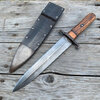JN01
Member
A few years back, when I used to live in Ohio, I was heavily into reenacting the 1770s-80s settlement era. I had a number of blades, most of which I ended up selling when I retired from the hobby.
There are a lot of fur trade and later Western style blades on this forum, but there doesn't seem to be many from the colonial era.
If anyone has some, let's see them.
I'll start. Here are three of mine, all hand forged, draw filed, and hand finished in the 18th Century manner.
Custom soldier's folder by Scott Summerville. Exact copy of a circa 1750 one that was excavated from a historical site (I believe in PA).


There are a lot of fur trade and later Western style blades on this forum, but there doesn't seem to be many from the colonial era.
If anyone has some, let's see them.
I'll start. Here are three of mine, all hand forged, draw filed, and hand finished in the 18th Century manner.
Custom soldier's folder by Scott Summerville. Exact copy of a circa 1750 one that was excavated from a historical site (I believe in PA).


Last edited:
















